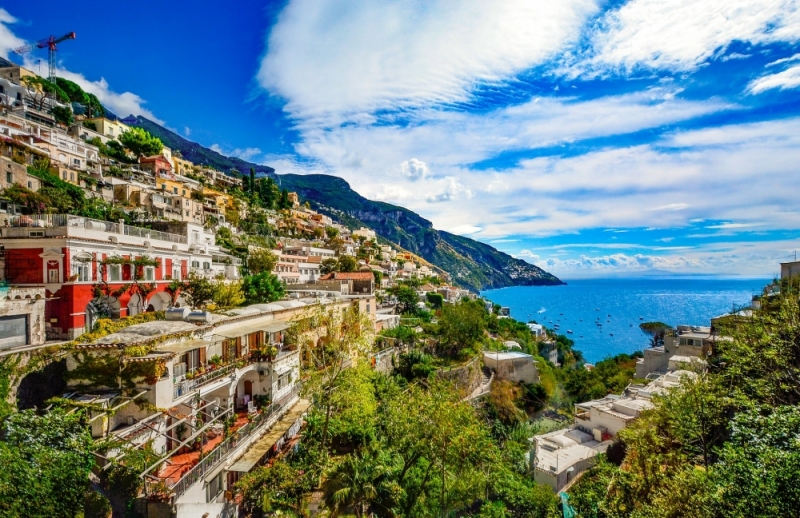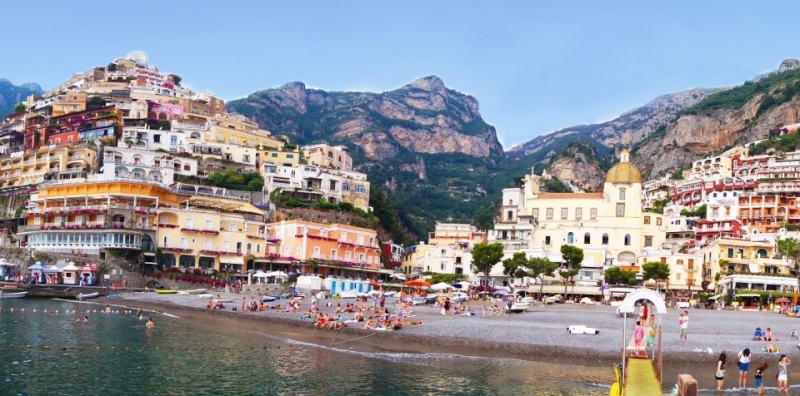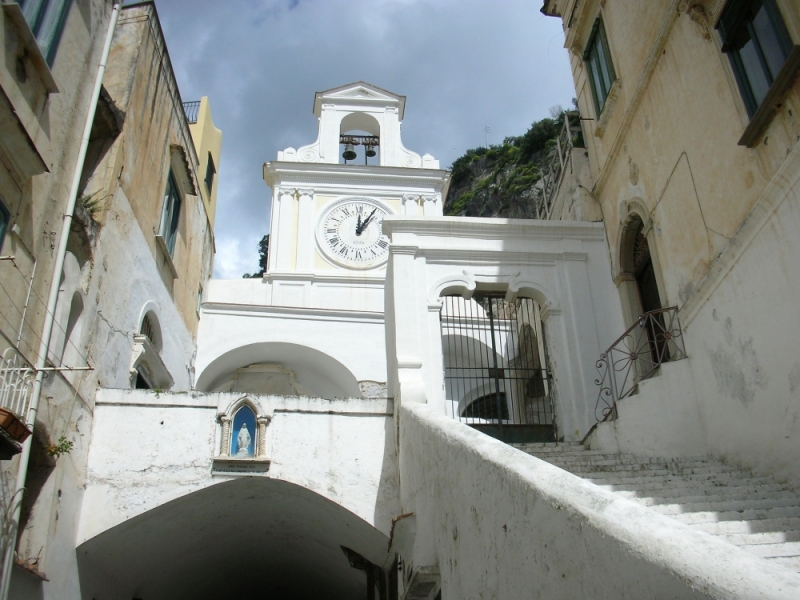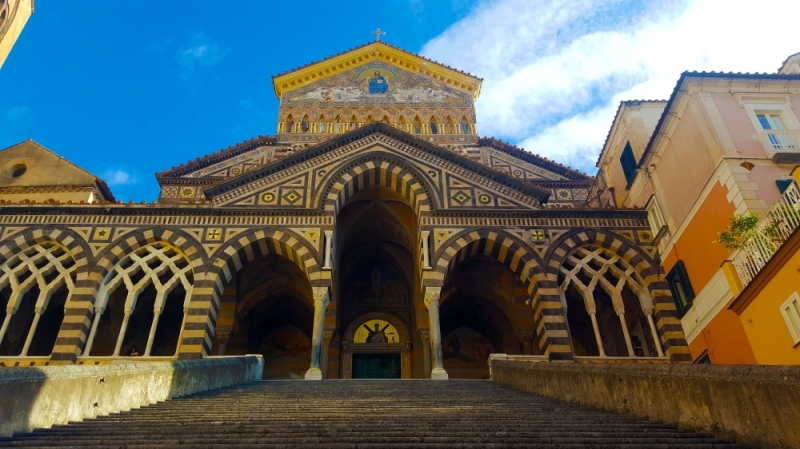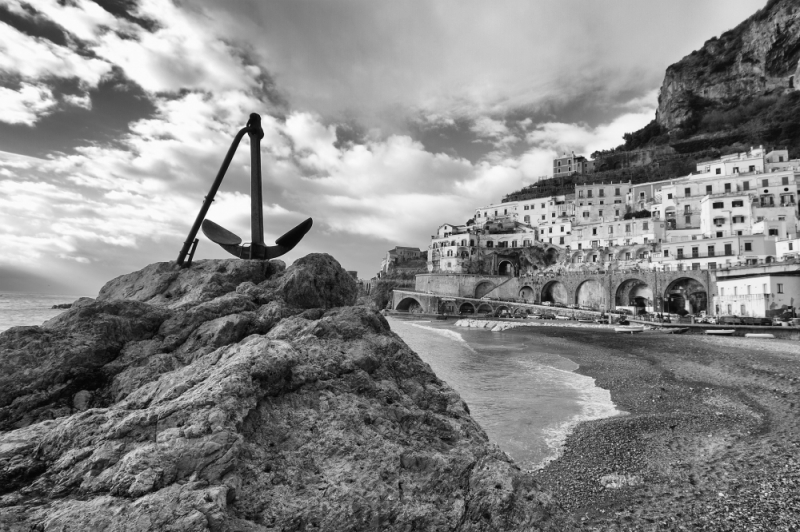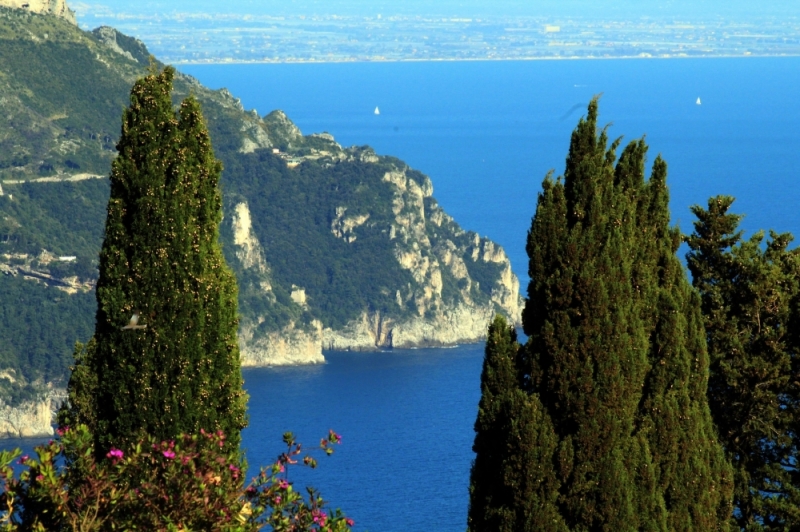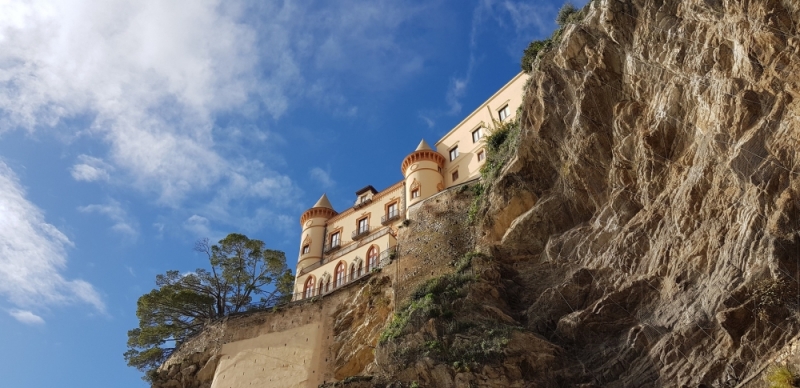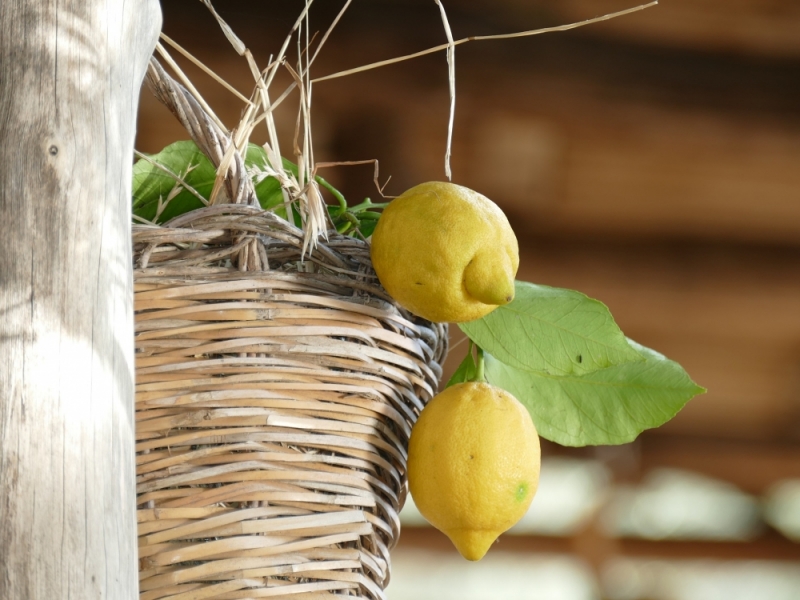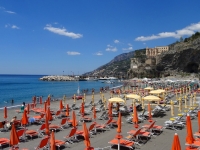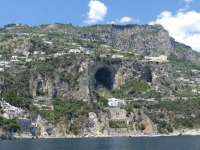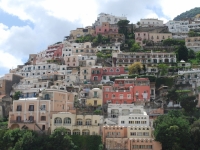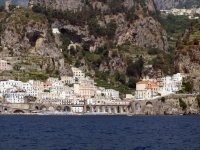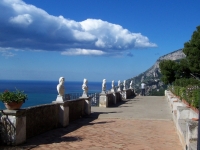The villages of the coast are a UNESCO World Heritage Site
The Amalfi Coast or Amalfi Coast is one of the most beautiful stretches of coast in Italy. It is located between Naples and Salerno and a stretch of coast that starts from Positano, its pearl, and for 50 km reaches Vietri, the last municipality on the coast. The history of these small seaside villages has very ancient origins. In fact, it seems that the Amalfi Coast was already inhabited by the ancient Romans, as demonstrated by the numerous Roman villas found in its territory. Subsequently, during the Middle Ages, Amalfi, together with Genoa, Pisa and Venice, became one of the 4 Maritime Republics that competed for dominance of trade in the Mediterranean Sea. However, once conquered by the Normans, Amalfi and the entire coast lost their splendor, also due to the continuous looting by Pisa. It was only in the nineteenth century that the Amalfi Coast was rediscovered by young English romantics, who left from Great Britain and completed the Grand Tour of Italy, to rediscover Italian art, culture, literature and poetry, arriving up to here, in these villages overlooking the sea, where the sea and the sky join on the horizon. But to discover all the secrets and history of the many villages that make it up, we invite you to get in your car or, better yet, on your motorbike and follow us in discovering the Amalfi Coast. The Amalfi Coast has been awarded the prestigious title of "World Heritage Site" by UNESCO, which recognized it as an extraordinary example of a Mediterranean landscape rich in cultural and natural values. This precious area has been shaped by the difficult topography and the long historical process of adaptation of the local community, demonstrating a brilliant example of sustainable resource use. The universal value of the Amalfi Coast lies not only in its intrinsic beauty, but also in the way in which man has been able to adapt harmoniously to this unique environment.
Positano
Leaving Naples behind, from Sorrento you can take the "Nastro Azzurro" state road . Attention, we are not talking about beer, but of the Strada Statale 163 which is the road that starting from Positano will make you cross all the towns of the Amalfi Coast, which are located overlooking the sea. Exactly, starting from Positano , perhaps the most famous after Amalfi; certainly the most appreciated by the whole international jet-set, in fact, Positano was and is the destination of the holidays of the most famous world stars, such as Princess Grace Kelly, Sophia Loren, in the past, but also Leonardo Di Caprio and Beyoncè who recently have visited " the divine ", nickname with which Positano is defined for its beauty. According to legend, it seems that the name Positano derives from Poseidon who had fallen in love with the nymph Pasitea who resided in this place. Positano is a beautiful village, perched, with its houses overlooking the sea.
Arriving by car, as soon as you turn the curve, you will find yourself admiring the majolica dome of the Basilica of Santa Maria Assunta , built after a picture of the Madonna was brought to Positano which, speaking through the picture, indicated to the inhabitants where he wanted it to be built the new church. The Basilica is one of the most beautiful in Italy and, due to its charm, many couples choose to get married here. Other than that, we absolutely don't want to advise you what to see or where to go. We advise you, rather than get lost for the alleys, among the stairs of the beautiful town, perhaps stopping at " La Zagara ", one of the historical places, to taste a lemon delight, or even simply go shopping in the shops that sell the clothes of the famous " Positano Fashion ". If you are in Positano on a hot spring or summer day, then put on your swimsuit and go to Spiaggia Grande for a swim. From the beach, looking upwards you will have the most suggestive view of Positano, with its colorful houses that wind along the mountain, overlooking the sea.
Praiano
Continuing our itinerary, after Positano, along the way you will meet Praiano , a small fishing town, less famous than Positano but to which it has nothing to envy, as Praiano is also a beautiful village. Praiano takes its name from its most beautiful beach, La Praia , which is so called because it derives from the Greek plagion which means beach. Praiano is the village of churches. In its small territory there are 13 of them, dating back to the 15th and 18th centuries. To get out of anonymity and counter the fame of its neighbor, Positano, the citizens of Praiano invented the NaturArte project. These are 8 itineraries in which, walking through the alleys and among the colorful stairways of the town, you can admire the 150 contemporary works of art , created to revisit the main characteristics and traditions of the village, but also to admire the sunset from Piazza Constantinople , where there is the chapel dedicated to Santa Maria di Costantinopoli , very suggestive. Finally, you can take advantage of the stairs to go directly to the sea, even if we assure you that the "ascent" will not be a walk at all. In addition to the aforementioned La Praia, Praiano has another beautiful beach, La Gavetella , a cove much loved by tourists. The Gavetella has an exposure that allows the sun to illuminate it from sunrise to sunset. From here, you can enjoy a beautiful panorama of Positano and Capri.
Furore
You will realize that you have arrived in Furore when you start to see the houses with the paintings on the facades. In fact, Furore is famous for being the "painted country" . Furore is also famous for its fjord , a rift in the rock that opens overhanging the sea and where, every year, on the occasion of Marmeeting, there are beautiful diving competitions, against a spectacular background. But if you are afraid of diving, you can always take advantage of the fjord beach , to sunbathe or even swim in a fantastic sea. Furore is the country that does not exist, as, unlike the other towns of the Amalfi Coast, Furore does not develop as a single agglomeration of houses, but is more a succession of houses that wind along the rocky coast. Furore is a fishing village, chosen by Roberto Rossellini and Anna Magnani who lived their troubled love story here. As evidence of this, there is also a small museum at Villa della Storta where you will find the permanent museum dedicated to the great actress. Finally, for all lovers, it is possible to walk the Love Walk , which starts from the Church of Sant'Elia , up to the Contrada della Cicala , where a statue with two lovers will be waiting for you, inviting all lovers to travel the path that will take you to enjoy a wonderful view.
Conca dei Marini
Conca dei Marini is the fourth smallest municipality in Italy. The village is located in a real basin, from which the name of the village comes. On the main road, before arriving in the village, you can park to go down, through the stairs or with the lift, to the Emerald Grotto , a cavity, in the coast from which the sun enters and gives the water a beautiful emerald green hue. Hence the name of the cave. We advise you to enter the cave where you can admire the wonders of marine nature, with rocks and stalactites. On the backdrop, there is even a crib , placed there in 1956. Every year, at Christmas, divers place flowers on the feet of the Child Jesus. Entering the village, we recommend you to visit the Church of San Giovanni Battista , which is located on a rock in the district of Penne. As in all the municipalities of the Amalfi Coast, here too there are beautiful churches, with majolica and important sacred works which, unfortunately, have often been damaged in the past. But Conca dei Marini is the sea town in all respects, just as suggested by its name and therefore, you cannot avoid taking a bath at the beach of Marina di Conca , a bay surrounded by houses, where in the 17th century it was a tradition to elect Mayor. Here, in the past, Jacqueline Kennedy and Gianni Agnelli have also relaxed.
Amalfi
Amalfi is the largest and most important village on the entire coast, in fact it is from Amalfi that the coast takes its name. Amalfi was one of the four maritime republics in the Middle Ages, together with Genoa, Venice and Pisa, its great rival. It seems that the name Amalfi, according to legend, was the name of the woman loved by Hercules and that he had buried her here, on the shores of the Tyrrhenian Sea and therefore Amalfi has also become the name of the village. When you arrive from Statale 163, you will see that Amalfi is a beautiful village surrounded by the landscape of the Valle delle Ferriere Reserve and wet, in fact, by the Tyrrhenian Sea. Venturing out to discover the village, you will be enraptured by the beautiful Cathedral of Amalfi , dedicated to Sant'Andrea, the patron saint of the town. In order to access the cathedral, you will have to climb the very long staircase that has often been used as a theater for social events, such as parades and important awards. The Cathedral of Amalfi, in addition to being a cathedral, is a real complex, made up, in fact, of the cathedral, the Cloister of Paradise and the Church of the Crucifix . The cathedral is in Arab-Sicilian style and the beautiful mosaic on the central facade is the perfect expression of it. In the square in front of the cathedral there is the Fountain of Sant'Andrea , a beautiful statute with marble sculptures, from where it can see water from the Sele river. Amalfi is also famous for the paper produced in Amalfi since the Middle Ages, which is currently used mainly for important announcements, such as weddings and prestigious ceremonies. In Amalfi you can visit the Amalfi Paper Museum . Furthermore, if you love walking, you can go to the Vallone delle Ferriere , where there were ironworks for the production of paper. Currently only one of these can be visited. If instead you are interested in the history of Amalfi as a Maritime Republic, we recommend a visit to the Arsenale , where the most important activities took place in the Middle Ages and where many finds are kept.
Atrani
Atrani is the smallest municipality in Italy and on the Amalfi Coast. The village is located about 1 km from Amalfi, along the valley of the Dragone river, enclosed between Monte Civita and Monte Aureo. Thanks to its perched position, its cobbled streets, its stairways and its very suggestive atmosphere, Atrani has often been used for film and advertising sets, for spots and films, current but also from the past. Atrani is a small fishing village that hides incredible wonders, such as the Collegiate Church of Santa Maria Maddalena , dating back to 1200, or the Church of San Salvatore de 'Birecto , dating back to the 10th century. According to legend, moreover, it seems that Masaniello was hiding here, the Neapolitan revolutionary who had to flee from Naples, as he was sought after by the King's guards and who took refuge in the cave that takes his name, precisely Masaniello Cave . It is possible to access the cave through 500 steps. Perched on Monte Aureo is the Torre dello Ziro, a fortress in which Joan of Aragon, the illegitimate daughter of Henry of Aragon and better known as Giovanna the Madwoman, seems to have been locked up.
Ravello
We leave Atrani to move to Ravello , the city of music, a nickname dedicated to him as the Ravello Festival dedicated to the great German composer Richard Wagner who stayed in Ravello since May 1880 is held here every summer. Ravello, thanks to its 350 meters above sea level sea, is a terrace overlooking the Gulf of Salerno. Ravello has very ancient origins. It seems, in fact, that it was founded around the fifth century by the inhabitants of Southern Italy to hide from the Barbarians who sacked and plundered everything, following the fall of the Western Roman Empire. Ravello is the cultural heart of the coast, in fact, since the nineteenth century it has been a destination for artists, musicians and men of culture who stayed in Ravello to relax and enjoy the wonderful panorama. It is also here that the most beautiful villas on the Amalfi Coast are located, such as Villa Episcopio , where King Vittorio Emanuele II took refuge during World War II, but also Villa Cimbrone , today a large hotel, famous for its beautiful terrace of the infinite . In Piazza Duomo, where the Cathedral of Ravello is located, dating back to the 11th century, you can also see Villa Rufolo , dating back to the 13th century, was the building where the powerful Rufolo family resided; subsequently Wagner stayed there and it is here that the festival is held every year in his honor. Definitely worth visiting are the gardens of Villa Rufolo. Returning to the Duomo, we recommend you to visit it as inside there is a sumptuous chapel dedicated to San Pantaleone , patron saint of Ravello, where the relic of his blood is kept and if you are in Ravello on the occasion of the annual feast of the Saint Patron you may be lucky enough to witness the liquefaction of blood. For all music lovers, who come to Ravello for the festival, you cannot miss a visit to the Auditorium of Ravello , designed by the Brazilian architect Oscar Niemeyer, where they played Lucio Dalla, the violinist Salvatore Accardo and where he also performed Toni Servillo. Finally, before leaving Ravello, we advise you to go to the Coral Museum , where in addition to seeing how the coral is made and to be able to see ancient jewels and lucky charms, obtained from it, you will also receive a sprig of coral, as the tradition has it that coral is "red, broken and given away".
minors
Minori is the city of Sal De Riso , one of the best known Italian pastry chefs, the one who invented the infamous Ricotta and Pera, which you can taste in his pastry shop on Corso di Minori. The first settlements of this hamlet, which is located on the inlet of Capo d'Orso, date back to the 1st century AD. C., when the Romans chose it as a destination for their summer residences. As evidence of this, there is the Roman Villa Marittima , which must have belonged to some noble and wealthy Roman family who stayed here during the summer. The Villa was found in 1954, as it had been buried by the many floods that had hit Minori. Walking through Minori, we recommend you to visit the Basilica of Santa Trofimena , the patron saint of Minori, whose remains were found on the town beach around the seventh century AD and which are still kept inside the church today. In the past, Minori was full of mills that served as pasta factories. Pasta is a tradition still alive today and in the restaurants of the village you can taste the many specialties of Minori, including the "'ndunderi", the ricotta, parmesan and egg gnocchi which should be seasoned only with tomato sauce. Remember to taste them before leaving Minori.
Maiori
Maiori is one of the largest towns on the Amalfi Coast. Its Maggiore beach is certainly the largest on the whole coast, as following the flood of 1954, this stretch of coast was smoothed out, leaving room for a volcanic sandy beach, among the most beautiful in the entire Costa d ' Amalfi. In addition to this beach, Maiori also has other beaches, real coves and some of these, such as Cala Bellavia , also known as Cavallo Morto , or the Bay of Glauco , bordering Erchie, which can only be reached by sea. In addition to the beautiful beaches, in Maiori you can also visit the Collegiate Church of Santa Maria a Mare , a 13th century church, located on a hill that is located in the center of the village. Inside the church are kept the remains of San Clemente, patron of the town and also the museum of sacred art dedicated to Clemente Confalone. If you feel adventurers and you have the strength, we advise you to walk the path and climb the long staircase that will lead you to the Castle of San Nicola de Thoro-Plano , built before the year 1000 and still open to the present day, with a nice guide that is none other than the owner of the castle. In addition to the beautiful guided tour, you will also enjoy wonderful views. Definitely worth visiting is Erchie , a very small village, which is part of the municipality of Maiori and only 121 inhabitants live there. The small village opens onto the main beach, nestled between two rock walls. You will understand that you have arrived in Erchie, when you see the famous Norman Tower , a defensive tower dating back to 1300 which today has become an elegant and evocative location for ceremonies.
Cetara
Cetara is the last village on the Amalfi Coast, before arriving in Vietri , to which we have dedicated a separate section. Cetara is a fishing village, famous worldwide for its anchovy sauce . Just like in Vietri, also in Cetara you can find the famous majolica of Vietri ceramics that decorate and color the streets and houses of the village. Cetara overlooks its beautiful beach and is overlooked by Monte Falerio. In addition to the wonders of unspoiled nature that dominates these places, we recommend that you visit the 17th century Church and Convent of San Francesco and the 11th century Vicireale Tower , where the Saracens hid. Cetara is the village where you can enjoy many delicacies, such as the anchovy sauce, or the fresh tuna fillets caught by fishermen, especially during the Tuna Festival held every year in summer. For anchovies, you can participate in the Night of the Lampare , a night in which you can fish the anchovies, only guided by the lights of the " lampare ", the lanterns that the fishermen light up on their boats. La Notte delle Lampare is a night of celebration, with songs and dances of popular music and the opportunity to taste fresh fish.
Climate, curiosity and advice
Climate: The Amalfi Coast is a real paradise, as it is beautiful in all seasons. Surely the best time is spring, in fact, from April to June, the coast is colored with the bright colors of spring, the temperatures rise, but they are not as hot as in summer and above all, on the beaches, there is no crowding of the summer months. Also, no less important is the fact that in the spring hotel prices are lower than in the summer and we assure you that it is a really important thing, as the Amalfi Coast can be very expensive. However, it is in summer that the most important events take place, such as the feasts of patron saints and festivals. In the summer it will be very easy to meet VIPs and notice the yachts of important characters of the international Jet-set ... who knows you won't meet some Holliwood stars. Even on autumn days the coast will reserve you days at sea, when temperatures are still good. In winter, however, you can still enjoy suggestive views of the winter sea which, often rough, hurls itself against the rocky coast. However, consider that in winter many structures can be closed.
Curiosity: In a hamlet of Vietri, which is called Raito, you can visit the museum of Vietri ceramics, which is located in a beautiful villa, Villa Guariglia, which was also the residence of King Vittorio Emanuele III during the World War. Villa Guariglia was also the infamous Villa Isabella, during the filming of the TV series Capri, which aired on Rai 1.
Tips: We advise you to visit the Amalfi Coast in periods other than July and August for valid reasons. First of all, you will certainly find the crowded beaches, in fact, considering that they are almost all of the coves, we advise you to go very early in the morning if you want to find a place. Furthermore, just because they are small and exclusive, the costs of the bathing establishments on the beaches are quite high, as well as those of the hotels and restaurants. Finally, we give you culinary advice. Do not go away from the Amalfi Coast without first trying the limoncello made with the lemon from the Amalfi Coast bread, also known as Sfusato Amalfitano. This lemon is used in many ways, in fact as well as for limoncello, it is used for desserts, such as babà or the famous lemon delight, but also to be eaten raw, or on fish dishes or served as granita. Don't miss it for any reason in the world.


